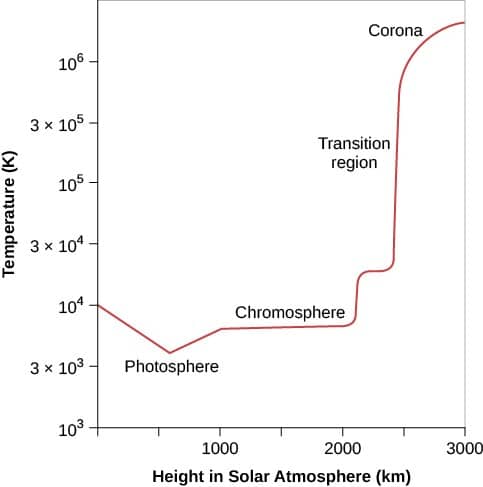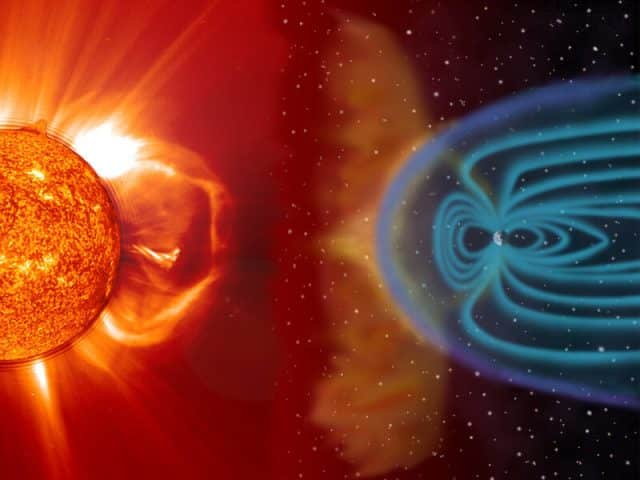- The Sun, like all stars, is an enormous ball of extremely hot, largely ionized gas, shining under its own power.
- The Sun could fit 109 Earths side-by-side across its diameter, and it has enough volume (takes up enough space) to hold about 1.3 million Earths.
- The Sun does not have a solid surface or continents like Earth, nor does it have a solid core. Most of the elements found in the Sun are in the form of atoms, with a small number of molecules, all in the form of gases: the Sun is so hot that no matter can survive as a liquid or a solid.
- In fact, the Sun is so hot that many of the atoms in it are ionized, that is, stripped of one or more of their electrons. This removal of electrons from their atoms means that there is a large quantity of free electrons and positively charged ions in the Sun, making it an electrically charged environment. (Scientists call such a hot ionized gas a plasma.)
- About 73% of the Sun’s mass is hydrogen, and another 25% is helium (i.e. Sun is composed of roughly 98% hydrogen and helium). All the other chemical elements (including those we know and love in our own bodies, such as carbon, oxygen, and nitrogen) make up only 2% of our star.
- Sun is rotating in counter-clockwise direction (when viewed from a long way above Earth’s north pole).
- Those objects closer to the Sun, which are more affected by heat and light pressure, are composed of elements with high melting points & Objects farther from the Sun are composed largely of materials with lower melting points.
- Stars like Sun are rare in Milky Way galaxy, whereas substantially dimmer and cooler stars, known as red dwarfs, are common.
Characteristics of the Sun
- Age: 4.6 billion years.
- Diameter: 1.39 million km.
- Temperature: 6000 °C on surface and 16 million °C in core.
- Density: 1.41 times that of water.
- Our gaseous sun is divided into different zones and layers, with each of our host star’s regions moving at varying speeds. On average, the sun rotates on its axis once every 27 days. However, its equator spins the fastest and takes about 24 days to rotate, while the poles take more than 30 days. The inner parts of the sun also spin faster than the outer layers, according to NASA.
- Gasses spin at different rates, therefore, while the sun does indeed rotate on its axis, different parts of the sun rotate at different speeds. It does not rotate at a constant rate like solid Earth. The differential rotation of the sun helps contribute to sunspots, magnetic fields, and radiation.
The Sun’s Internal Structure and Atmosphere
- The Sun’s layers are different from each other, and each plays a part in producing the energy that the Sun ultimately emits.
- The solar interior, from the inside out, is made up of the core, radiative zone and the convective zone.
- Inside the core, nuclear energy is being released. The core is approximately 20% of the size of the solar interior and is thought to have a temperature of approximately 15 million K, making it the hottest part of the Sun.
- Above the core is a region known as the radiative zone—named for the primary mode of transporting energy across it. This region starts at about 25% of the distance to the solar surface and extends up to about 70% of the way to the surface.
- The light generated in the core is transported through the radiative zone very slowly, since the high density of matter in this region means a photon cannot travel too far without encountering a particle, causing it to change direction and lose some energy.
- The convective zone is the outermost layer of the solar interior. It is a thick layer approximately 200,000 kilometers deep that transports energy from the edge of the radiative zone to the surface through giant convection cells, similar to a pot of boiling oatmeal. The plasma at the bottom of the convective zone is extremely hot, and it bubbles to the surface where it loses its heat to space. Once the plasma cools, it sinks back to the bottom of the convective zone.

Solar Photosphere
- The photosphere is the lowest layer of the solar atmosphere and visible “surface” of the Sun.
- The photosphere is the bright outer layer of the Sun that emits most of the radiation.
- The photosphere is an extremely uneven surface.
- The effective temperature on the outer side of the photosphere is 6000°C.
Chromosphere
- The chromosphere is the second of the three main layers in the Sun’s atmosphere and is roughly 3,000 to 5,000 kilometers deep.
- Its rosy red color is only apparent during eclipses.
- The chromosphere sits just above the photosphere and below the solar transition region.
- It is relatively a thin layer of burning gases.
- The temperature of the chromosphere is about 10,000 K.
Transition Region
- The increase in temperature does not stop with the chromosphere. Above it is a region in the solar atmosphere where the temperature changes from 10,000 K (typical of the chromosphere) to nearly a million degrees.
- The hottest part of the solar atmosphere, which has a temperature of a million degrees or more, is called the corona.
- Appropriately, the part of the Sun where the rapid temperature rise occurs is called the transition region. It is probably only a few tens of kilometers thick.
Corona
- The outermost part of the Sun’s atmosphere is called the corona. Like the chromosphere, the corona was first observed during total eclipses.
- Unlike the chromosphere, the corona has been known for many centuries: it was referred to by the Roman historian Plutarch and was discussed in some detail by Kepler.
- The Sun’s corona extends millions of kilometres into space and is most easily seen during a total solar eclipse.

Solar Wind
- The solar wind is a stream of energised, charged particles, primarily electrons and protons, flowing outward from the Sun at speeds as high as 900 km/s and at a temperature of 1 million degrees (Celsius).
- It is made of plasma (ionised atoms).

Effects of solar wind (Aurora)
- An aurora is a natural light display in the sky, predominantly seen in the high latitude (Arctic and Antarctic) regions. (This is due to magnetic field lines of earth and solar wind)
- Auroras are caused by charged particles, mainly electrons and protons, entering the atmosphere from above causing ionisation and excitation of atmospheric constituents, and consequent optical emissions.
Solar flares
- Solar flares are produced on the sun’s surface due to magnetic anomalies.
- They are magnetic storms which appear to be very bright spots with a gaseous surface eruption.
- As solar flares are pushed through the corona, they heat its gas to anywhere from 10 to 20 million °C.
Solar prominence
- An arc of gas that erupts from the surface of the Sun is called solar prominence.
- Prominences can loop hundreds of thousands of miles into space.
- Prominences are held above the Sun’s surface by strong magnetic fields and can last for many months.
- At some time in their existence, most prominences will erupt, spewing enormous amounts of solar material into space.
Plasma
- Plasma is one of the four fundamental states of matter, the others being solid, liquid, and gas.
- Plasma is ionised gas (atoms and molecules are converted into ions typically by removing one or more electrons from the outer shell)
- Lightning and electric sparks are everyday examples of phenomena made from plasma.
- Neon lights could more accurately be called ‘plasma lights’, because the light comes from the plasma inside of them.

Coronal Holes

- A coronal hole is a temporary region of relatively cool, less dense plasma in the solar corona where the Sun’s magnetic field extends into interplanetary space as an open field.
- Compared to the corona’s usual closed magnetic field that arches between regions of opposite magnetic polarity, the open magnetic field of a coronal hole allows solar wind to escape into space at a much quicker rate. This results in decreased temperature and density of the plasma at the site of a coronal hole, as well as an increased speed in the average solar wind measured in interplanetary space.
- They have lower temperatures and appear much darker than their surroundings as they contain little solar material.
- Coronal holes can last between a few weeks to months.
- The holes are not a unique phenomenon, appearing throughout the sun’s approximately 11-year solar cycle.
- They can last much longer during solar minimum, a period of time when activity on the Sun is substantially diminished.
- Significance: Coronal Holes are important in understanding the space environment around the earth through which our technology and astronauts’ travel.
References: NCERT, G C Leong, Wikipedia, lumenlearning.com

Mind-blowing
Thanks….really appreciable